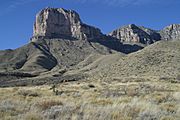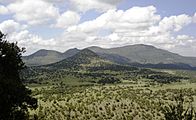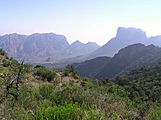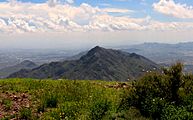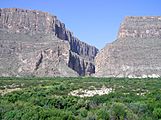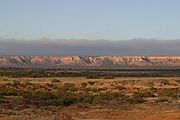West Texas facts for kids
Quick facts for kids
West Texas
|
|
|---|---|
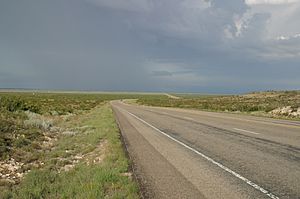
West of Notrees
|
|
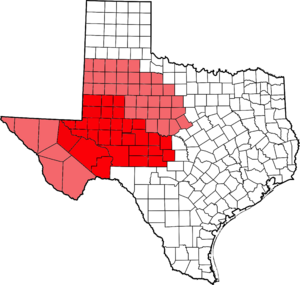
West Texas counties in red; counties sometimes included in West Texas in pink
|
|
| Country | United States |
| State | Texas |
| Largest city | El Paso |
West Texas is a large area in the western part of the U.S. state of Texas. It's known for its dry, desert-like weather. This region is generally west of a line connecting cities like Wichita Falls, Abilene, and Del Rio.
People don't always agree on where West Texas officially begins or ends. It's a bit different from East Texas. West Texas is part of the American Southwest, with its dry climate and desert landscapes.
This big region has different natural features. The part west of the Pecos River is often called "Far West Texas" or the "Trans-Pecos". This area is the driest part of the state and is within the Chihuahuan Desert. Another famous part is the Llano Estacado, which is a huge, flat plain that stretches into Eastern New Mexico. East of the Llano Estacado are the "redbed country" of the Rolling Plains and the Edwards Plateau to the south. These areas help connect the eastern and western parts of Texas.
Contents
What is the Climate Like in West Texas?
West Texas gets much less rain than other parts of Texas. It has a dry or semi-dry climate. Because of this, most farms in the area need a lot of water from irrigation. Water for irrigation often comes from underground sources, like the Ogallala Aquifer.
Some parts of West Texas have rough land with many small mountains. Other parts are closer to sea level. The northern areas and higher mountains in the Trans-Pecos region sometimes get heavy snowfall in winter. Snow is less common in other parts of West Texas.
What are the Major Cities in West Texas?
West Texas is home to several important cities. El Paso is the largest city in the region. Here are some of the biggest cities:
| Rank | Image | City | County(ies) | Population (2023 Estimate) |
|
|---|---|---|---|---|---|
| Region | State | ||||
| 1 | 6 |  |
El Paso | El Paso | 678,958 |
| 2 | 10 | 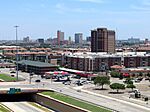 |
Lubbock | Lubbock | 266,878 |
| 3 | 25 | 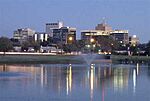 |
Midland | Midland, Martin | 138,397 |
| 4 | 29 |  |
Abilene | Taylor, Jones | 129,043 |
| 5 | 34 | 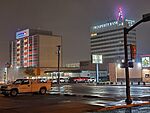 |
Odessa | Ector, Midland | 115,743 |
| 6 | 43 | 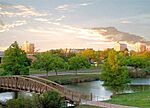 |
San Angelo | Tom Green | 99,262 |
| 7 | 95 | 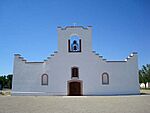 |
Socorro | El Paso | 38,238 |
| 8 | 133 | 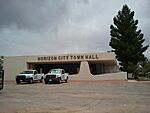 |
Horizon City | El Paso | 24,168 |
| 9 | 140 | 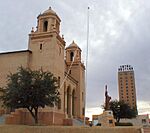 |
Big Spring | Howard | 22,373 |
| 10 | 155 |  |
Plainview | Hale | 19,420 |
Many smaller cities and towns are also found in West Texas. These include places like Alpine, Pecos, and Marfa.
What is the Economy of West Texas Like?
The economy of West Texas relies on several key industries. These include:
- Raising livestock (farm animals)
- Producing petroleum (oil) and natural gas
- Growing textiles like cotton and grain
- The defense industry, thanks to large military bases like Fort Bliss
West Texas has also become famous for its many wind turbines. These turbines create clean, alternative electricity from the wind. In recent years, the region has seen a strong period of economic growth, often called the "West Texas oil boom."
-
Irrigated agriculture in West Texas
-
The Brazos Wind Farm near Fluvanna is one of many wind farms in West Texas.
-
Fort Bliss is a major employer in the El Paso area.
What Sports Teams are in West Texas?
West Texas doesn't have major league sports teams, but people are very loyal to their local high school and college teams.
- College Teams:
- NCAA Division I teams include the Texas Tech Red Raiders and the UTEP Miners.
- NCAA Division II teams include the West Texas A&M Buffaloes, the Texas–Permian Basin Falcons, and the Lubbock Christian Chaparrals and Lady Chaps.
- Professional Minor League Teams:
- El Paso hosts the El Paso Chihuahuas, a AAA baseball team.
- The El Paso Locomotive FC plays in the USL Championship, which is the second-highest level of soccer in the U.S.
- Baseball fans can also cheer for the Midland RockHounds and Amarillo Sod Poodles in double-A baseball.
- For junior hockey, the Odessa Jackalopes play in the North American Hockey League.
How is "West of the Pecos" Used in Popular Culture?
- Further information: West of the Pecos
The phrase "West of the Pecos" has become a popular saying, especially in Western movies and stories. It often means a wild, untamed place where rules might not apply. For example, you might hear phrases like "Fastest draw west of the Pecos."
The famous novel No Country for Old Men by Cormac McCarthy and its movie version take place in West Texas. Much of the movie was also filmed there.


